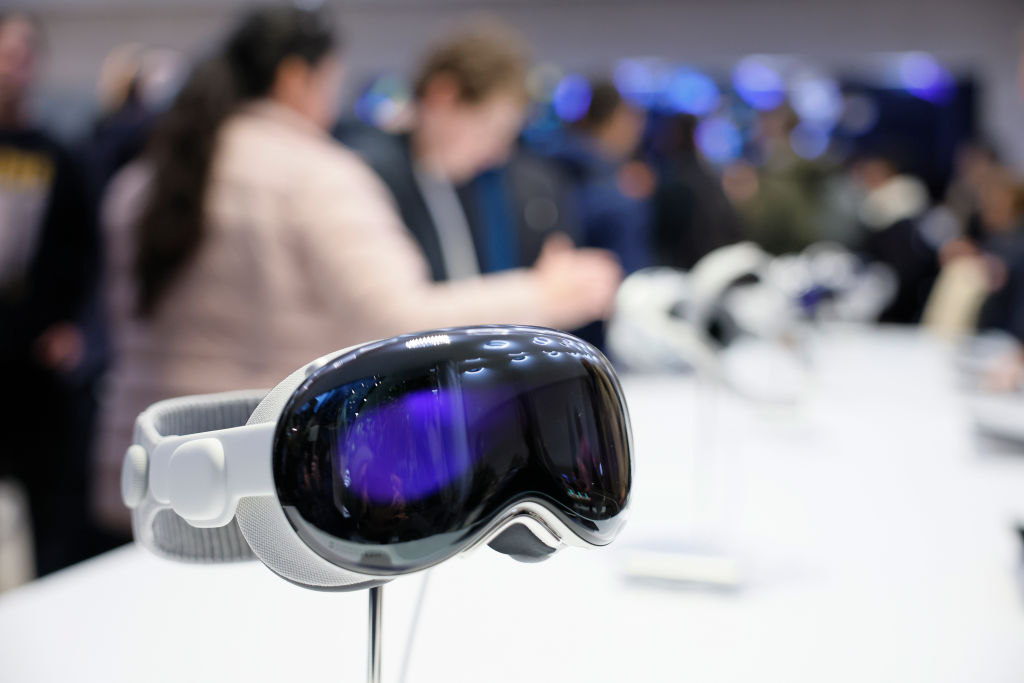Apple’s Strong Start in Virtual Reality
Apple’s first year in the VR market sets it up for long-term success. The tech giant’s vision will take years to pay off, though.


To help you understand what is going on in the tech sector our highly experienced Kiplinger Letter team will keep you abreast of the latest developments and forecasts (Get a free issue of The Kiplinger Letter or subscribe). You'll get all the latest news first by subscribing, but we will publish many (but not all) of the forecasts a few days afterward online. Here’s the latest…
Apple certainly wasn’t the first to launch a virtual-reality headset. But its high-tech, and high-priced, device officially kicked off the virtual reality era. The tech giant will sell over 400,000 units of the Apple Vision Pro in 2024, according to a recent forecast by tech market research company IDC.
Enthusiasm over Apple’s VR debut has been subdued, to say the least. Sales are lower than some analysts had hoped, which has led to naysayers voicing concerns over the viability of VR devices more generally. However, it’s a strong showing for a first-generation headset that starts at a lofty $3,500.

Sign up for Kiplinger’s Free E-Newsletters
Profit and prosper with the best of expert advice on investing, taxes, retirement, personal finance and more - straight to your e-mail.
Profit and prosper with the best of expert advice - straight to your e-mail.
Part of this early push has been getting the device into the hands of software developers so that they can create VR apps and content. Apple is leaning into business uses for the Vision Pro, but sales are split between employers and consumers. Recently, sales slowed in the United States, but have picked up in overseas markets.
A cheaper Vision model is likely to jump-start sales next year and in 2026. The lighter headset will have fewer features and will probably cost around $1,500, with Apple aiming to eventually get its low-cost version priced at $1,000 or less. Considering that there are quality VR devices on the market today that cost $500 or less, driving down the cost of Apple’s version will be key. Apple is also working on an augmented-reality device, a super-lightweight headset that is more like normal glasses that overlay digital information onto the real world.
Facebook-owned Meta is showing what the future of slim electronic glasses could look like. Meta’s Ray-Ban smart glasses have become a hit with diehard users and have exceeded the company’s sales expectations. The Ray-Ban glasses, which start at $300, look like stylish sunglasses but include open-ear speakers, five microphones, a 12-megapixel camera, 32 gigabytes of storage and Wi-Fi/Bluetooth connectivity. Users can give voice commands to snap a photo, video livestream what’s in front of them, listen to music, learn about things in front of them or answer questions via Meta’s artificial intelligence assistant.
Both Meta and Apple want to make AR glasses that are stylish and sleek. Meta is reportedly working on a future set of smart glasses that can display information on the inside of the lens. Apple’s AR headset will have to strike a difficult balance between useful features and lightweight design. A lingering problem with AR devices is users’ limited willingness to wear the glasses all day. Similarly, today’s VR goggles are too bulky and alienate many would-be customers.
It's still a long road ahead for VR to hit the mainstream. Apple will continue a strong VR push, even if it faces some tough sales years in the future. The company has experience launching devices that failed to meet analysts’ sales expectations in the first year, yet went on to commercial success, such as the Apple Watch.
Part of that road map includes doubling down on VR entertainment. Apple recently announced a new collection of upcoming video content for the Vision Pro, including immersive concerts, nature documentaries, virtual hot-air balloon rides and surfing videos. Expect bigger efforts on the production front. Early adopters are still lacking in things to watch and do in VR.
This forecast first appeared in The Kiplinger Letter, which has been running since 1923 and is a collection of concise weekly forecasts on business and economic trends, as well as what to expect from Washington, to help you understand what’s coming up to make the most of your investments and your money. Subscribe to The Kiplinger Letter.
Get Kiplinger Today newsletter — free
Profit and prosper with the best of Kiplinger's advice on investing, taxes, retirement, personal finance and much more. Delivered daily. Enter your email in the box and click Sign Me Up.

John Miley is a Senior Associate Editor at The Kiplinger Letter. He mainly covers technology, telecom and education, but will jump on other important business topics as needed. In his role, he provides timely forecasts about emerging technologies, business trends and government regulations. He also edits stories for the weekly publication and has written and edited e-mail newsletters.
He joined Kiplinger in August 2010 as a reporter for Kiplinger's Personal Finance magazine, where he wrote stories, fact-checked articles and researched investing data. After two years at the magazine, he moved to the Letter, where he has been for the last decade. He holds a BA from Bates College and a master’s degree in magazine journalism from Northwestern University, where he specialized in business reporting. An avid runner and a former decathlete, he has written about fitness and competed in triathlons.
-
 6 Stunning Waterfront Homes for Sale Around the US
6 Stunning Waterfront Homes for Sale Around the USFrom private peninsulas to lakes, bayous and beyond, Kiplinger's "Listed" series brings you another selection of dream homes for sale on the waterfront.
By Charlotte Gorbold Published
-
 Six Reasons to Disinherit Someone and How to Do It
Six Reasons to Disinherit Someone and How to Do ItWhether you're navigating a second marriage, dealing with an estranged relative or leaving your assets to charity, there are reasons to disinherit someone. Here's how.
By Donna LeValley Published
-
 The New Space Age Takes Off
The New Space Age Takes OffThe Kiplinger Letter From fast broadband to SOS texting, space has never been more embedded in peoples’ lives. The future is even more exciting for rockets, satellites and emerging space tech.
By John Miley Published
-
 Rising AI Demand Stokes Undersea Investments
Rising AI Demand Stokes Undersea InvestmentsThe Kiplinger Letter As demand soars for AI, there’s a need to transport huge amounts of data across oceans. Tech giants have big plans for new submarine cables, including the longest ever.
By John Miley Published
-
 What DOGE is Doing Now
What DOGE is Doing NowThe Kiplinger Letter As Musk's DOGE pursues its ambitious agenda, uncertainty and legal challenges are mounting — causing frustration for Trump.
By Matthew Housiaux Published
-
 A Move Away From Free Trade
A Move Away From Free TradeThe Letter President Trump says long-term gain will be worth short-term pain, but the pain could be significant this year.
By David Payne Published
-
 The Explosion of New AI Tools
The Explosion of New AI ToolsThe Kiplinger Letter Workers and consumers soon won’t be able to escape generative AI. Does that mean societal disruption and productivity gains are right around the corner?
By John Miley Published
-
 Trump’s Whirlwind Month of Crypto Moves
Trump’s Whirlwind Month of Crypto MovesThe Kiplinger Letter The Trump administration wants to strengthen U.S. leadership in the cryptocurrency industry by providing regulatory clarity.
By Rodrigo Sermeño Published
-
 Excitement Over AI Propels IT Spending
Excitement Over AI Propels IT SpendingThe Kiplinger Letter IT sales set to surge in 2025 as businesses rush to adopt generative AI.
By John Miley Published
-
 Donald Trump Tests His Limits
Donald Trump Tests His LimitsThe Kiplinger Letter President Encounters Legal Obstacles in Pursuit of Ambitious Agenda.
By Matthew Housiaux Published